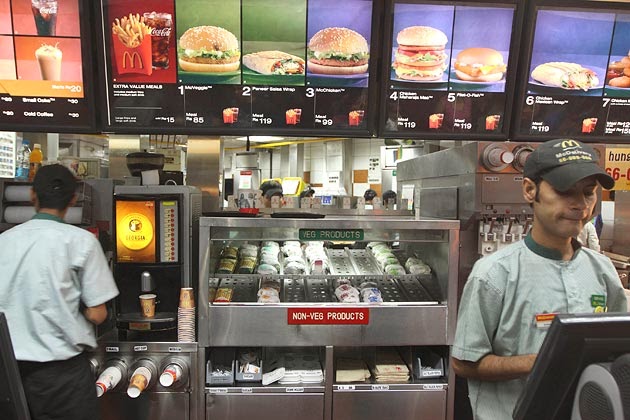The McDonald's is the world's largest chain of hamburger fast food restaurants, serving around 68 million customers daily in 119 countries. When I walked into a McDonald's in India, I came to know about their
'Enjoy! 60 second service', where customers who are made to wait any more than
a minute for their order would receive a free McDonald's burger of our choice.
As a customer, I gazed upon the timer after placing my order, silently praying
that they screw something up so that I can get a free burger of my choice. To my surprise, I received my ordered items within 45 seconds and was
really amazed by the way how everything works systematically. I later even came
to know that McDonald's was ranked No.2 all over the world for their best
supply chain management according to an annual supply chain management
recognition list published by IT research company Gartner, Inc.
In matters dealing with suppliers, McDonald’s does indeed
have a secret sauce. The secret sauce of McDonald’s success is found within
long-term transparent relationships based on the unwavering belief that
everyone in the McDonald’s System can and should win.
There are five ingredients that have proved as success
factors for McDonald’s.
Ingredient 1: Focus on Outcomes, Not Transactions
McDonald’s consciously makes a decision to NOT conduct business
with strategic suppliers on a transactional relationship – but instead insists
suppliers have long-term relationships that drive business value and achieve
McDonald’s key business outcomes. The secret to making it work is the fact that
McDonald’s and its most strategic suppliers have a deep commitment to each
other to continually deliver value for McDonald’s System. Suppliers are
confident the McDonald’s business is not vulnerable to competitors’
price-cutting and arbitrary change. And McDonald’s is confident that its
suppliers are delivering the best possible value and looking out after McDonald’s
interests to protect and grow the System.
Ingredient 2: Focus on the What, Not the How
One of the ingredients of Kroc’s secret sauce was to know
McDonald’s core competency versus his suppliers. While the founder had the
vision, he knew he needed to rely on the suppliers and restaurant
owner/operators for implementation. When it came to suppliers, Kroc- and later
Fred Turner – took the help by setting the standards for the famed QSC&V (Quality, Service, Cleanliness
& Value), and at the same time, entrusting the suppliers to use their
brainpower to determine “how” to best meet McDonald’s exacting standards.
Ingredient 3: Agree on Clearly Defined & Measurable Outcomes
The Supplier
Performance Index is an in-depth The Supplier Performance Index is an
in-depth evaluation tool used by McDonald’s and its suppliers to assess levels
of success. Typically, the SPI covers six categories- management, Systems
First, Assured Supply, Quality Systems, Innovation, and Predictable Competitive
Pricing. The scores are secondary to the conversation that ensues. The SPI
leads to insight, calibration, alignment and bench-marking.
Ingredient 4: Pricing Model/Incentive for Cost/Service Trade-Offs
The pricing system comes back to the concept of the
three-legged stool. McDonald’s, store owner/operators and suppliers each must
secure a profitable, long term financial picture – one that keeps the company
first and, as such, secure stable futures for all.
Another McDonald’s goal is to ensure price stability for the
restaurants. Frequent changes to menu price result in owner/operator worry
about the price of beef or profit pressure. For this reason, McDonald’s and
suppliers usually revise pricing protocols every 1-3 years based on the
category and the region.
Ingredient 5: Govern for Insight, Not Oversight
McDonald’s uses a peer-to-peer relationship between supplier
and McDonald’s for each level – from operational to executive. The peer-to-peer
alignment is a pro-active approach to managing business. To McDonald’s –suppliers are part of the planning and
execution of their Plan to Win. It’s not just business –it’s personal.
I want you people to think on these lines and try to analyse
what Apple can learn from McDonald’s in India.
What Apple Can Learn from McDonald’s in India?
McDonald’s has even clearly planned their strategy for their
target customers in India by having separate slots for “Veg” and “Non-Veg”
products at McDonald’s in India. To
succeed in India, these companies develop products that the local market wants
and at disruptive price points. No one exemplifies this better than McDonald’s.
By offering a completely Indian and largely vegetarian menu at a median price
of 50 cents, McDonald’s has created one of the fastest-growing restaurant chains
in a country that is largely vegetarian and where the cow is sacred. Incredible!
Thus, from these ingredients its very clear that McDonald’s,
its owners/operators, and their suppliers have created a System to be reckoned
with –a System that continues to set records after 50 years. The trust in the
System inspires collaboration that is unparalleled in other supplier
relationships that drive process and product innovations on a regular basis.
References:
http://retailindustry.about.com/od/technologyinnovations/a/Retailers-Best-Supply-Chain-Management-Apple-Amazon-Mcdonalds-Walmart-Recognition.htm
http://www.businessweek.com/articles/2013-07-03/what-apple-can-learn-from-mcdonalds-in-india
http://www.vestedway.com/wp-content/uploads/2012/09/mcdonalds-case-study.pdf


No comments:
Post a Comment
Note: Only a member of this blog may post a comment.